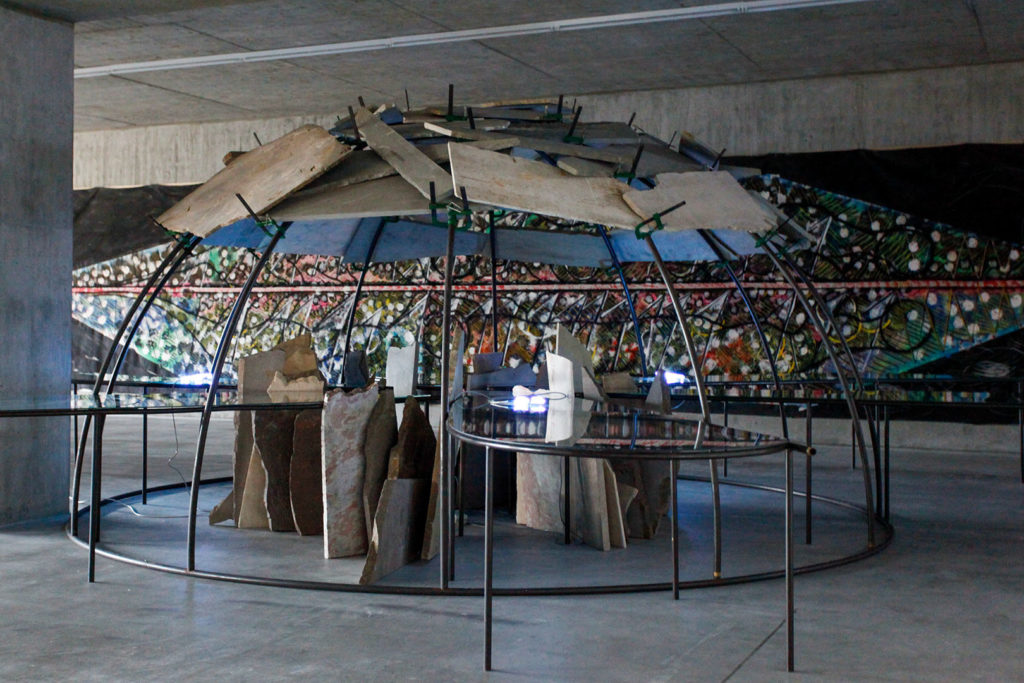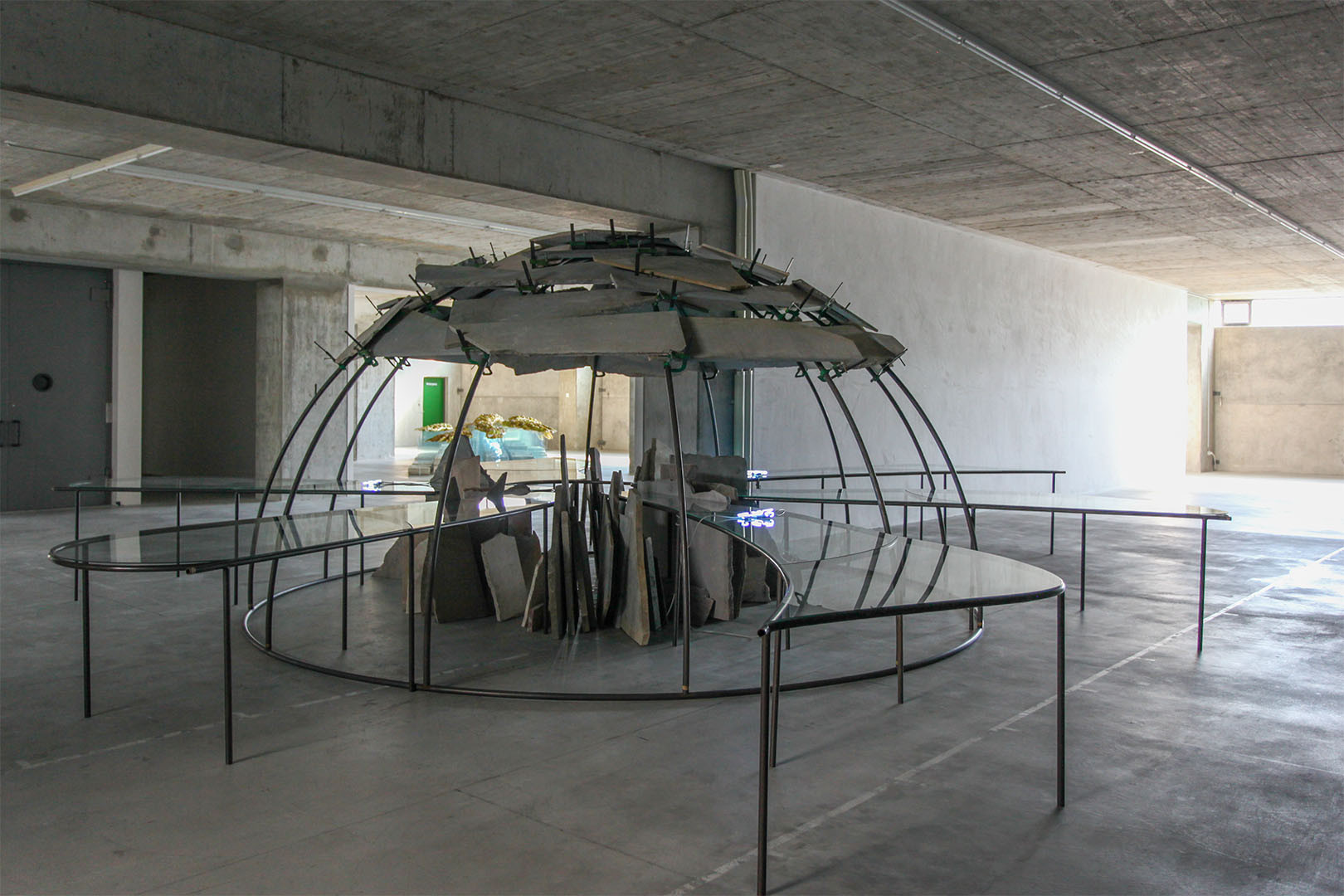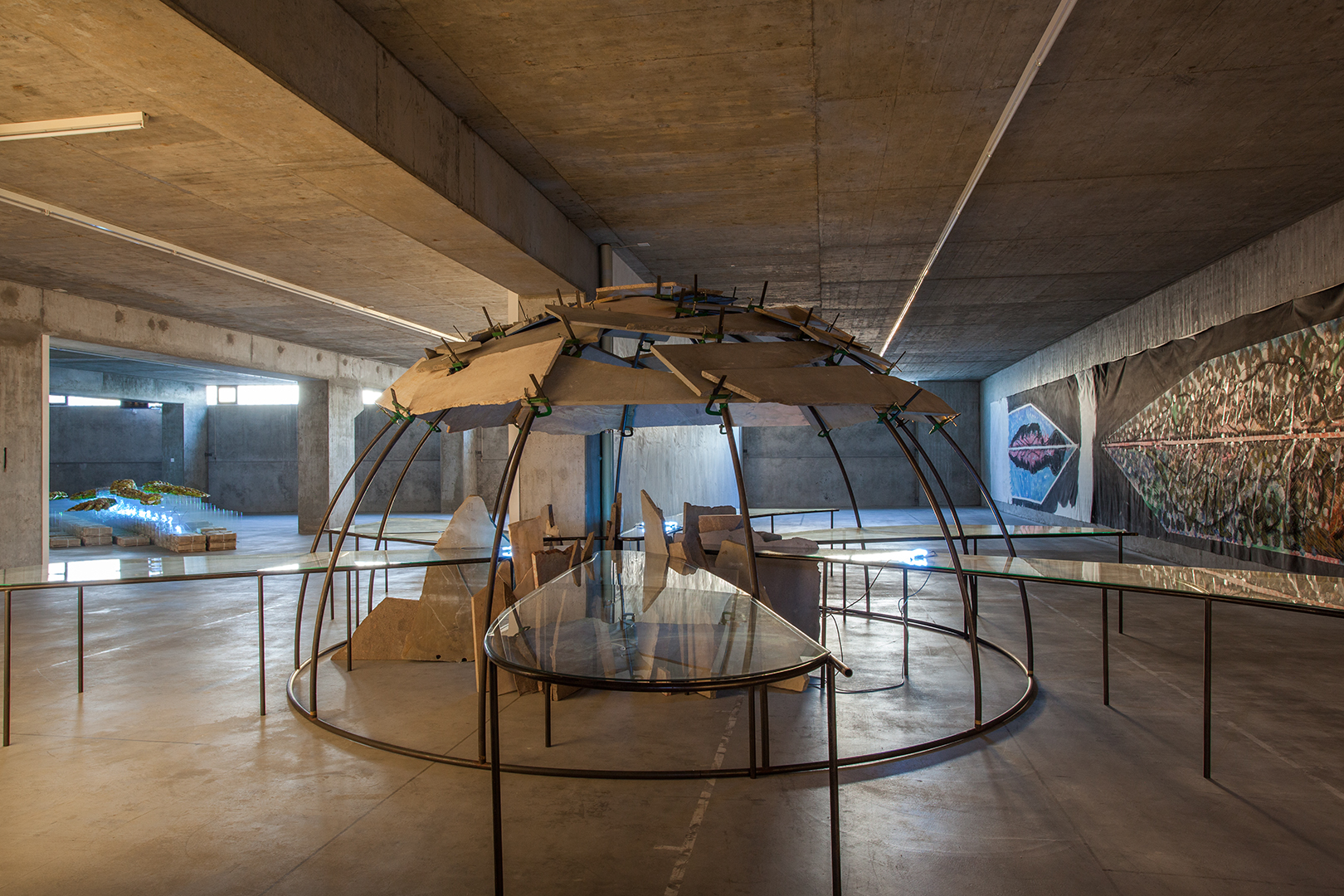An Igloo as Image of the World
by Christel Sauer

Focus on: ‘I gradini mangiano la scala o la scala mangia i gradini,’ 1995, by Mario Merz, steel, stone, glass, neon numbers and screw clamps, 250 × 916 × 840 cm
The door opens and we see an image of the world. It is made out of stone and glass, and out of curving sections of tubular steel, which, as a filigree structure in space, outline the shape of a half a terrestrial globe. The dome is canopied with slabs of stone – like the sky with dense cloud. They form a heavy, closed ceiling above an open, airy space and despite their weight seem to maintain themselves in a floating state. Rising towards them from the floor below, almost as if growing out of it, are other pieces of stone of different composition and origin: upright, broken fragments with tips that tower like mountains. They pass through into a second, higher level, in which large sheets of glass supported on tubular steel frames reach from the centre of the hemisphere horizontally outwards into the surrounding space. The outline of these glass panes calls to mind the petals of a flower. The reflection of light on their surfaces, on the other hand, makes us think sooner of water and the oceans that surround the rocky land beneath the sky. Neon numbers, lying like flowers on three of the six panes of glass, infuse the “water” with a light blue colour and the whole with a mysterious glow.1
But Merz’s 1995 work can also be described in a different way – as the organic compound, for example, of elements that appear as constants in the artist’s oeuvre in manifold variations: the igloo, the (glass) tables and the (luminous) Fibonacci numbers. The igloo, elemental dwelling, has the shape of a hemisphere: it is connected to the floor of the room in which it stands, rises above it and returns to it. The tables form a plane parallel to the floor: raised on their legs above the ground, they separate the space above and below them. The numbers denote, in a rapidly increasing series of additions, the principle of growth and spread – a continuously expanding process to which everything in nature is subject and which adds the aspect of time to that of space. Time is also found in the slabs of stone, which contain, in their compressed state, the unimaginably long history of their formation and thus expose the lifetime of the viewer as a terrifyingly brief instant. Their compact, closed nature is countered by the tempered transparency of the glass, which opens up a view of space and time far beyond the immediate surroundings.
Talking about its prototype many years before he built the present igloo, Mario Merz said: “When I made the igloo, I acted with a power of vision. The igloo is not just the elementary form but also the point of departure for fantasy.”2 The stone-roofed hemisphere offers a commanding sight – an invitation, in physical form, to surrender to the spontaneous images that arise when looking at the primeval structure. In the presence of Merz’s igloo, it is not difficult to activate our imagination and to experience the phenomenon before us as a trigger of stirring emotions. Nothing in the work seeks to instruct or assert, even though it becomes clear, upon looking more closely, that the artist’s seemingly intuitive approach is based on a fund of knowledge. Merz was interested all his life in the major relationships that link the world’s infinitely diverse manifestations into an inseparable whole. Full of respect for the unlimited power of creation, he made this power the basis of his artistic approach and a guarantor of its validity. Upon his profound admiration for nature, with her ordered systems and random coincidences, Mario Merz has built a body of work full of soul in an unmistakable visual language.

About the Title
When Merz’s igloo was exhibited for the first time in 1995 at the Prague City Gallery,3 the art museum published a small catalogue containing a photograph of the installation. Printed below the picture in Czech and Italian were three lines written by the artist:
“i gradini mangiano la scala o la scala mangia i gradini …
la scala mangia i gradini o i gradini mangiano la scala …
nell’ organico trovare le regole della geometria è piuttosto improbabile”
[the steps eat the staircase or the staircase eats the steps …
the staircase eats the steps or the steps eat the staircase …
finding the rules of geometry in the organic is fairly unlikely]
The first line later became the title of the work. In the catalogue of his Merz exhibition in Brazil, for example, Danilo Eccher reproduced the igloo under the name I gradini mangiano la scala o la scala mangia i gradini …4 It is not clear whether it was Merz himself who gave his work this title, or whether it resulted from the adoption of a typical Merz aphorism, which offered a welcome means of identifying this igloo as opposed to the many Senza titolo.5 Mario Merz has written a great deal. Like his sculptural works, his texts are poetically visual and often cryptic in their effect. “The steps eat the staircase or the staircase eats the steps” seems to bear little relation, in terms of content, to the igloo. A key to an interpretation is found only the third line, in which the organic – as it appears in the form of the igloo and the numbers on the glass tables – is demarcated from the rules of geometry. But this line did not become the title.
Returning to the verse that serves as title, we find a thoroughly realistic aspect in its image of stairs and steps. When we ascend or descend a staircase, the number of steps lying before us diminishes: as the steps become fewer, so the staircase becomes shorter. Thus one indeed devours the other – and produces a fine metaphor.6 For Merz’s image can also be understood much more generally as a question of the relationship between a whole and its parts. Does the focus on the whole (the staircase) swallow the units of which it is composed (the steps), or does looking at the individual parts limit our view of the whole? Perhaps Merz’s verse may also be linked, however, to a text by the artist in which he speaks of “steps” of consciousness. In an essay of 1985 titled “Differences between consciousness and wisdom”,7 Mario Merz describes consciousness as a “series of revelations”, and specifically as “a series of steps, for use in time more than in space. They can be represented in space as steps of consciousness”. The series of – according to Merz, “practicable” – steps of consciousness is thus to a certain extent the stairway of a continuous process of cognition.
It is nevertheless not mandatory to decode Merz’s trains of thought in order to recognize the essence of his artistic statements – however interesting it is to try. Verse and sculpture stand for themselves and, even without a direct relationship, have their meaning. Merz has often created dialectic factors, which – like the igloo itself – he understood as a starting point for the imagination. The capacity to give form to inner images in different ways, to thus bring them into the world and leave them to the subjective perception of others, was a force that drove him all his life.
About the Location
After the exhibition in Prague for which it was first created, the work was shown in 1997 at the 47th Venice Biennale – albeit without the neon numbers on the glass tables. On that occasion it formed part of an installation in the Italian Pavilion, where Mario Merz erected four large igloos. One of these was the igloo with the gilded tips of tall glass triangles from this same year, which Urs Raussmüller exhibited from 2009 to 2014 in the Hallen für Neue Kunst in Schaffhausen.8 After its return from Venice, Merz installed the Prague work in Milan, in the Galleria Christian Stein on Via Gallarate. It is the artist’s only igloo that has planes, raised off the ground, projecting out from the centre into the room9 and requires an environment that allows it to occupy the fullness of its height and width without constraint. Merz surrounded it on the gallery walls with two of the three large paintings on cotton cloth that he had created and exhibited over a decade earlier for the original opening of the Galleria Christian Stein on Via Lazzaretto.10 Here in Milan, as previously in Venice, the igloo was Senza titolo – which is to say, “Untitled”.

Urs Raussmüller acquired the igloo and the paintings and created a spacious architecture for Merz in his building in Basel. Here, in 2012, Raussmüller installed three of his friend’s works: the over 10-metre long crocodile traversing the room (Senza titolo, coccodrillo11) of 1989, the igloo I gradini mangiano la scala o la scala mangia i gradini of 1995, and – at just under 25 metres – the longest and most complex of the untitled 1985 paintings.12 He gave Merz’s expansive art ample space in which to unfold and at the same time created a situation that concentrated the energy of the works. He positioned the igloo in such a way that it interlocks the spatial zones: the hemisphere’s projecting glass planes reach around a partition wall and turn towards both the crocodile and the painting. With its gyroscopic appearance, in this location the sculpture becomes a centre of rotation in a dynamic event, in which time plays a major role alongside space.
The constellation created by Raussmüller is a commentary in visual form on three chapters of evolutionary history. The large yellow crocodile made of balls of newspaper soaked in paint, which surfaces above panes of glass with luminous blue Fibonacci numbers as if above water, represents a creature that has lived on Earth for over two hundred million years. The reptile’s unaltered primordiality stands in formidable contrast to the fast-paced transience of daily life, which is manifested in the bundles of newspapers beneath it. In Merz’s long and powerful painting on the opposite wall, there unfolds a history of creation as found in archaic myths. Unshapely creatures emerge from beneath layers of colours and forms and, from the primeval waters, conquer new ground. The length of the cloth requires us to walk along beside it and thereby to experience its size as a length of time, too. With the unpainted areas, phases of evolution are passed over in order to continue the story at a more advanced stage.
The situation concentrates itself in the igloo with the stone dome and the projecting glass planes. The work seems like an embodiment of Merz’s world picture, which is oriented towards the broad outlines of the universal history of creation, against whose backdrop current events are put into perspective. It counters the short-term present moment with an awareness of the permanent and elemental, and thus embodies not least the principle of hope that is carried within the enormous arc of the passage of time.13
13.08.2020
Photos 1,3: Fabio Fabbrini, © Raussmüller; photo 2: Jürgen Buchinger, © Raussmüller
For Mario Merz © Mario Merz / 2020, ProLitteris, Zurich.
1 The neon numbers are 55, 987 and 1597, taken from the growth progression introduced by the medieval mathematician Leonardo da Pisa, known as Fibonacci.
2 Mario Merz interviewed by Suzanne Pagé and Jean-Christophe Ammann, in: Mario Merz, ARC, Musée d’art moderne de la ville de Paris / Kunsthalle Basel 1981, n. pag.
3 Mario Merz solo show at the Stone Bell House (Dům u Kamenného Zvonu), part of Prague City Gallery (Galerie hlavního města Prahy), 26.10.1995–22.1.1996
4 Danilo Eccher, Mario Merz, exh. cat, São Paulo, Rio de Janeiro and Salvador da Bahia 2003, pp. 46/47
5 The Fondazione Merz lists the work under the title I gradini mangiano la scala….
6 Mario Merz was clearly interested in the theme of steps and staircases. An installation of 1992, for example, bears the title 74 gradini riappaiono in una crescita di geometria concentrica (“74 steps reappear in a growth of concentric geometry”; information from Maddalena Disch). An earlier work of 1971 shows neon numbers in the Fibonacci sequence on the steps of a staircase.
7 Mario Merz, “Differences between Consciousness and Wisdom”, cited here from: Kristine Stiles & Peter Selz (eds.), Theories and Documents of Contemporary Art. A Sourcebook of Artists’ Writings, 2nd rev. and exp. edition, Berkeley and Los Angeles 2012, pp. 781/782. First published in: Germano Celant (ed.), Arte Povera/Art Povera, Milan 1985, p. 207.
8 See Urs Raussmüller, Christel Sauer (eds.), Mario Merz. Senza titolo, Basel 2011, text: Christel Sauer
9 Work commentary by Maddalena Disch, Fondazione Merz, Turin
10 Merz created the paintings in the summer of 1985 in the rooms of the Galleria Christian Stein prior to its opening, where he worked with the cotton support laid out on the floor. When it came to their hanging, he responded to the limited wall length here and later in the Via Gallarate by allowing the almost 25-metre-long cloth to hang down at each end like drapery. In Basel, Urs Raussmüller has given the work a wall more than 27 metres in length, so that it can be displayed in its entirety.
11 Mario Merz, Senza titolo (Coccodrillo), 1989, 112 x 1041 x 277 cm; see also the Raussmüller publication Mario Merz, Senza titolo (Coccodrillo), ed. by Christel Sauer, with a text by Jürgen Buchinger, Basel 2013.
12 Mario Merz, Senza titolo, 1985, mixed media on cotton cloth, 267 x 2471 cm
13 The Principle of Hope is a seminal work by the German philosopher Ernst Bloch. It was written between 1938 and 1947, while Bloch was living in exile in the US, and treats hope as a “concrete utopia”. First published in 1954.
